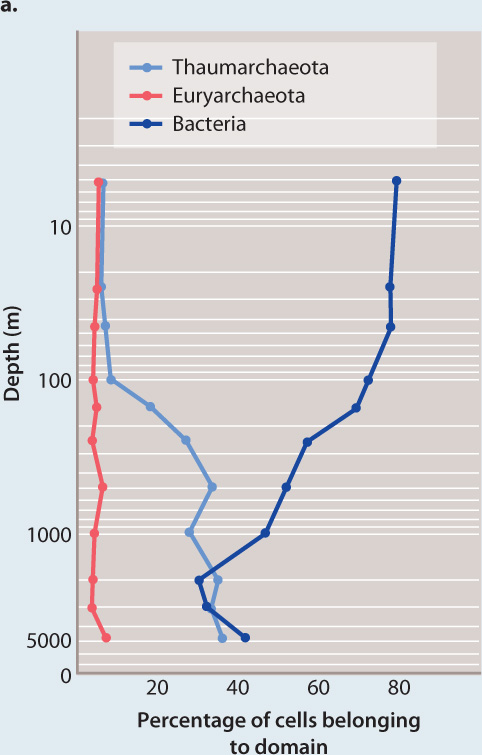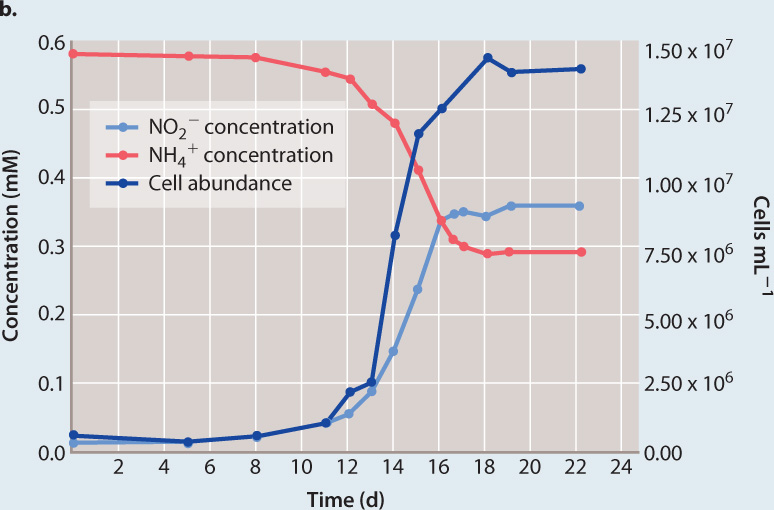Chapter 1. Working With Data 26.19
Working with Data: HOW DO WE KNOW? Fig. 26.19
Fig. 26.19 describes studies showing the abundance of Archaea in the oceans and their metabolisms. Answer the questions after the figure to practice interpreting data and understanding experimental design. Some of these questions refer to concepts that are explained in the following two brief data analysis primers from a set of four available on LaunchPad:
- Experimental Design
- Scale and Approximation
You can find these primers by clicking on the button labeled “Resources” in the menu at the upper right on your main LaunchPad page. Within the following questions, click on “Primer Section” to read the relevant section from these primers. Click on “Key Terms” to see pop-up definitions.
HOW DO WE KNOW?
FIG. 26.19: How abundant are archaeons in the oceans?
BACKGROUND Early exploration of microbial diversity in the oceans revealed that archaeons are tremendously abundant. Just how abundant are they, and what metabolisms do they employ to obtain energy and carbon?
METHOD Scientists sampled seawater throughout the depth of the ocean at a test site in the northern Pacific Ocean. To the samples, they added molecular tags bound to fluorescent molecules that are visible under the microscope. The tags were RNA sequences that bind to small-subunit ribosomal RNA genes known to be useful in identifying different types of bacteria and archaeons. In this way, separate fluorescent markers were attached to thaumarchaeote archaeons, euryarchaeote archaeons, and bacteria.
RESULTS By counting the cells marked by different fluorescent tags in seawater samples, the biologists showed that bacteria dominate microbial communities in near-surface seawater, but that thaumarchaeotes are as numerous as bacteria in deeper waters (Fig. 26.19a).

Surveys of cell abundance through a depth profile of the Pacific Ocean show that bacteria dominate cell numbers near the surface, but thaumarchaeotes make up about 40% of all cells in deeper waters.
CONCLUSION Marine thaumarchaeota, unknown in 1990, are now known to be among the most abundant organisms in the oceans.
FOLLOW-UP WORK Archaea are among the most abundant of all cells in the world’s oceans. How do these cells live? Microbial samples from water known to be sites of nitrification (that is, the conversion of ammonia to nitrite or nitrate) contained an abundance of thaumarchaeote cells. The high numbers of thaumarchaeotes from these communities supported the hypothesis that they are nitrifiers—the higher the abundance of thaumarchaeote cells (Fig. 26.19b, dark blue line), the higher the amount of nitrite (Fig. 26.19b, light blue line). Thaumarchaeotes were grown in pure culture and shown to grow by consuming ammonia (Fig. 26.19b, red line). In other words, they oxidize ammonia to provide the ATP and reducing power needed to incorporate CO2 into organic molecules. Therefore, they play a major role in the marine nitrogen cycle, thriving where sources of carbon and energy for other types of metabolism are scarce.

Growth of a marine thaumarchaeote in a medium containing ammonium chloride and bicarbonate as the only sources of energy and carbon, respectively. As cell number increased, ammonia (the ammonium ion NH4+) was increasingly converted to nitrite (NO2−), supporting the hypothesis that these cells are ammonia-oxidizing chemoautotrophs.
SOURCE Karner, M. B., E. F. DeLong, and D. M. Karl. 2001. “Archaeal Dominance in the Mesopelagic Zone of the Pacific Ocean.”Nature 409:507–510; Könneke, K., A. E. Bernhard, J. R. de la Torres, C. B. Walter, J. B. Waterbury, and D. A. Stahl. 2005. “Isolation of an Autotrophic Ammonia-Oxidizing Marine Archaeon.” Nature 437:543–546.
Question
Fig. 26.19a shows depth trends in the abundance of Bacteria and two groups of Archaea in the Pacific Ocean. How would you characterize the change in abundance with increasing depth for Thaumarchaeota? (Consider whether the graph provides proportional or absolute data.)
| A. |
| B. |
| C. |
| D. |